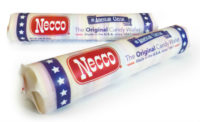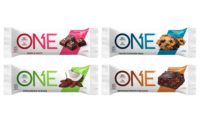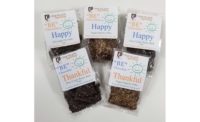
It’s not every day one receives an e-mail invtation to attend an “invention session” dubbed “Attack of the Killer Brains.”
Liam Killeen, Farley’s & Sathers’ ceo, smiles when asked to describe the meeting. It was, as he explains, two days of brainstorming that the management team had not previously experienced before.
Inspired and coordinated by Matthew Fenton, a former innovation consultant to consumer packaged goods companies and now Farley’s & Sathers’ vice president of marketing, the meeting featured facilitators to stimulate product innovation.
As Fenton points out, “Great new product ideas don’t just fall from the sky - you have to commit to finding and building them. At our two-day session, we had cross-functional representation - sales, operations, graphics, production, marketing - as well as a handful of ‘outside minds’ to ensure a broad base of ideas. Attendees were fed a steady stream of customized exercises and stimuli, each designed to attack a particular opportunity area.”
Such unorthodoxy may not have been part of the corporate culture in the past, but it’s definitely part of the mix for Farley’s & Sathers today.
“These sessions helped the management crew develop 400 new product concepts, of which two to three will become ‘great initiatives,’” Killeen says. Moreover, this will become “part of our routine,” he adds. “It’s not a one-time deal. It’s clear we have to improve in the area of product development.”
When pressed to ascertain whether Killeen had a benchmark number in mind regarding new product launches, he shook his head.
“Typically, some best-in-class companies look to generate 30% of their growth from new products,” Killeen says. “Numbers won’t help if consumers don’t love their products. So I’m not fascinated by such a target. We want to clearly identify what our brands mean to consumers and how do we delight them with these brands. If we do that well, the numbers will take care of themselves. There are no shortcuts.”

The former Storck executive and global confectionery industry veteran relishes the opportunity to grow a company with such powerful brands asBrach’s,Trolli,Farley’s,Sathers,Bob’s,Jujyfruits,Jujubes,Now and Later,Fruit StripeandRain-Blo.
“My agenda is to grow the brands,” he says. “The 25 years I’ve spent in the industry have been for this opportunity.”
It’s an opportunity that has brought Killeen full circle. In 1989, he was transferred to the United States from the United Kingdom to work as a marketing manager at Brach’s.
“I was working for Jacobs Suchard in England and was reassigned to the Oakbrook Towers office in suburban Chicago,” Killeen explains.
That kind of personal connection was exactly what Farley’s & Sathers’ executive board was looking for when it successfully completed the integration of the Brach’s acquisition two years after its purchase in 2007.
Thus, when Catterton Partners, a private equity firm, formed Farley’s & Sathers in 2002 - at the time a mix of former Farley’s Foods Candy Co. and Sathers Candy Co. assets as well as Kraft confectionery brands - its primary goal was to build the company up by improving its operations, introducing new products and exploring acquisitions, explains Dennis Nemeth, president.
Charged to oversee the process, Nemeth and the acquisitions team did so in quick succession, purchasing theJujyfruits,JuJubes,Heide andChuckles brands from The Hershey Co. in 2002;Now and Later from Kraft in 2002; theRain-Blo,Fruit StripeandSuper Bubblegum brands from Hershey in 2003;Bobs from Bobs Candy Co. in 2005; andTrolli from Wrigley in 2005. Finally, in 2007, it consummated its largest acquisition by buyingBrach’s.
As Nemeth notes, in a disciplined, “under the radar” fashion, Farley’s and Sathers became a sizeable confectionery concern, with sales estimated to reach $650 million this year (Candy Industry estimate).
“We had a small team that was focused on doing its groundwork before an acquisition, carefully doing our due diligence as well as examining the feasibility of a fair price,” he explains.
Referring to himself as an “operations guy,” Nemeth recognized that in addition to acquiring companies, his task involved integrating those purchases into a single entity.
“A lot of change occurs when you continuously acquire companies,” he says. That proved particularly true with the acquisition of Brach’s, which represented 30-40% of the company’s size.
“The purchase established us as who we are as a company,” Nemeth explains. “One of the key benefits was being able to retain key employees, good industry people.”
Since then, he has focused on creating internal processes to support a company of its size, be it in forecasting, processing, quality, financial or logistics.

Part of that process included hiring Killeen.
“We knew that we were moving into the next stage for the company, which is sales and marketing,” Nemeth says.
“Killeen’s the one that will move the company forward,” adds Nemeth, who plans to retire at the end of this year.
There’s plenty of evidence already that Farley’s & Sathers is, indeed, moving forward, bridging the gap that’s surfaced in sugar confectionery.
“Our retail partners tell us that there’s space in the non-chocolate category and that we are best positioned to take advantage of that scenario,” says Mike Sprinkle, v.p. – sales. “The space is looking for leadership.”
And although the past seven years have focused on a growth strategy involving operational initiatives and acquisitions, many of the company’s premier brands have benefitted from that growth and its accompanying infrastructure. For example, the Trolli brand has posted double-digit growth for the past several years and is the fastest-selling gummi in its category.
Brach’s seasonal confections continue to hold a leadership position in seasonal sales.
Another benefit, Sprinkle points out, is the distribution coverage that Farley’s & Sathers’ far-ranging brands have brought.
“We’re well-established in every channel, from food, drug and mass merchandise to value and specialty,” he says.
By using a combination of company sales people and brokers, the company can parlay strengths across the United States. Now it’s just a matter of reaffirming and, in some instances, re-establishing key brands amongst customers and consumers.
“We have some of the most enduring, iconic brands in America,” Killeen adds. “Unfortunately, some of them don’t have the same expansive reach.”
To build their prominence, the company has invested significant resources to talk to consumers about the brands and developing appropriate insights from those discussions.
“We’ve conducted focus groups with consumers,” Killeen says. “In my 25 years, I’ve never experienced consumers brought to tears talking about a brand. TakeBrach’s, for example. The consumer expects certainBrach’s products to define the season, be it candy corn for fall, nougats and canes for Christmas, conversation hearts for Valentine’s Day and jelly beans for Easter. Their calendar is punctuated byBrach’s products. These are incredibly loyal consumers.”
Such loyalty will not be unrewarded, as the company revs up its marketing and sales machine.
“Every brand in the Farley’s & Sathers portfolio has significant upside potential,” Fenton says. “While all brands will be given attention, our priorities for 2010 are two: RestoreBrach’s to glory, and continue the momentum behindTrolli. We’ve learned much about the consumers of each brand, and we’ll build unique, targeted programs to connect with them. While it’s too early to speak to specifics, tactics might include digital, social media, in-store and consumer promotions.”

“We’ve established what we call a Candy University for our sales and marketing personnel,” Sprinkle says. “No other non-chocolate confectioner has more knowledge than Farley’s & Sathers. One of the challenges that the management team faces is that we speak to the trade with one voice. Given that many of us have come together as a result of different acquisitions, it’s critical we come together as a single entity. As a result, the Candy University is a way that our sales and marketing people can understand our business completely.”
The “one voice” approach is already in place on an operations level, thanks to the groundwork established by Nemeth and ongoing efforts continued by Kevin McElvain, senior vice president of supply chain.
“These are exciting times here at Farley’s & Sathers,” McElvain says. “We’re in constant evolution to optimize the network, be it quality, engineering or R&D.”
For example, the company regularly undergoes BRC [British Retail Consortium] audits and is currently embarked on implementing a QACCP (Quality Analysis Critical Control Points) program by the end of the year.
QACCP is an extension of HACCAP (Hazardous Analysis Critical Control Points), a means at looking at quality-control points for specific products within the manufacturing process.
“We’ve embraced the ‘good guys do it all’ approach in manufacturing, meaning that we want do it right the first time,” McElvain says. “In doing so, costs go down, quality goes up.”
To do so, the company is implementing lean manufacturing techniques and automating the collection of data to measure overall equipment effectiveness (OE).
“We now have the scale to utilize comprehensive tools to review capacity, effectiveness and maintenance systems,” he says. “That has enabled us to reach a high standard across all six of our manufacturing facilities.”
A good case in point is the Creston, Iowa, facility. The 316,000-sq.-ft. plant features four mogul line and 29 packaging stations as well as a 98,000-sq.-ft. warehouse housing 8,000 pallet locations. It has the capability to produce both gelatin-based and starch-based product.
Currently, the facility is on pace to produce 100 million lbs. of product this year, says Brian Haines, plant manager. Sixty percent of the plant’s output involves gelatin-based products such as a gummies, with the remainder involving starch-based items such as fruit snacks.
Tracking OE at Creston, along with quality-control checks, has become part of the daily operating routine at the central Iowa plant. As Haines explains, OE combines three percentages involving performance, quality and availability.
“World-class plants typically have a 85% rating,” he says. And while the facility has hit that number, Haines says he wants to do so more consistently. It is a continuous improvement process.

“One of the improvements we made was to modify our change plates and nozzle plates so that operators could change those out using their hands instead of tools,” Haines says. “It allowed us to post a 10% improvement in our downtime.”
Such ongoing improvements will be necessary Killeen believes, particularly as the company’s emphasis on brands shifts into high gear next year.
As Fenton points out, “The way forward is through our brands. Consumers go looking forBrach’s,Trolli,Now and LaterandJujyfruits, not necessarily our corporate name. But when consumers flip the package over, we want them to see Farley’s & Sathers as synonymous with uncompromised quality and dependability - a name they can trust.”
It’s a trust that extends even beyond sugar confections to chocolate - Brach’s chocolate, that is.
“Chocolate has had a long history at Brach’s,” Killeen says. “From clusters to bridge mix to stars, the products are excellent. To us, it’s almost an ingredient to the things we’re doing.”
That said, Killeen promises that chocolate will remain a critical component of theBrach'srestaging. How chocolate will evolve within theBrach’s brand will depend upon ongoing consumer insights gleaned from the consumer. But one thing is certain: Chocolate remains a powerful draw to customers and consumers alike, something Killeen understands well.
“The potential for this portfolio is incredible,” he adds. So, too, is Farley’s & Sathers’ future. Competitors, beware: The Killer Brains are on the attack.
At a Glance
Farley’s & SathersHeadquarters: Round Lake, Minn.
Marketing Office: Chicago
Sales: $650 million (2010Candy Industryestimate)
Plants:6 (Creston, Iowa; Winona, Minn.; Chattanooga, Tenn. - 2; Reynosa and Linares, Mexico.
Employees: 2,700
Products:Hard candies, chewy candies, gummies, jellies, fruit snacks, candy canes, gum, candy corn, nougat, panned confections, chocolate-enrobed products
Brands:Brach’s, Trolli, Farley’s, Sathers, Bob’s, Jujyfruits, Jujubes, Now and Later, Fruit Stripe, Super Bubble and Rain-Blo
Output: 350 million lbs. annually
Management: Liam Killeen, ceo; Dennis Nemeth, president; Mike Sprinkle, v.p. – sales; Kevin McElvain, senior vice president of supply chain; Matthew Fenton, v.p. – marketing; Tammy Koller, cfo, Theresa Neuberger, v.p.-human resources





